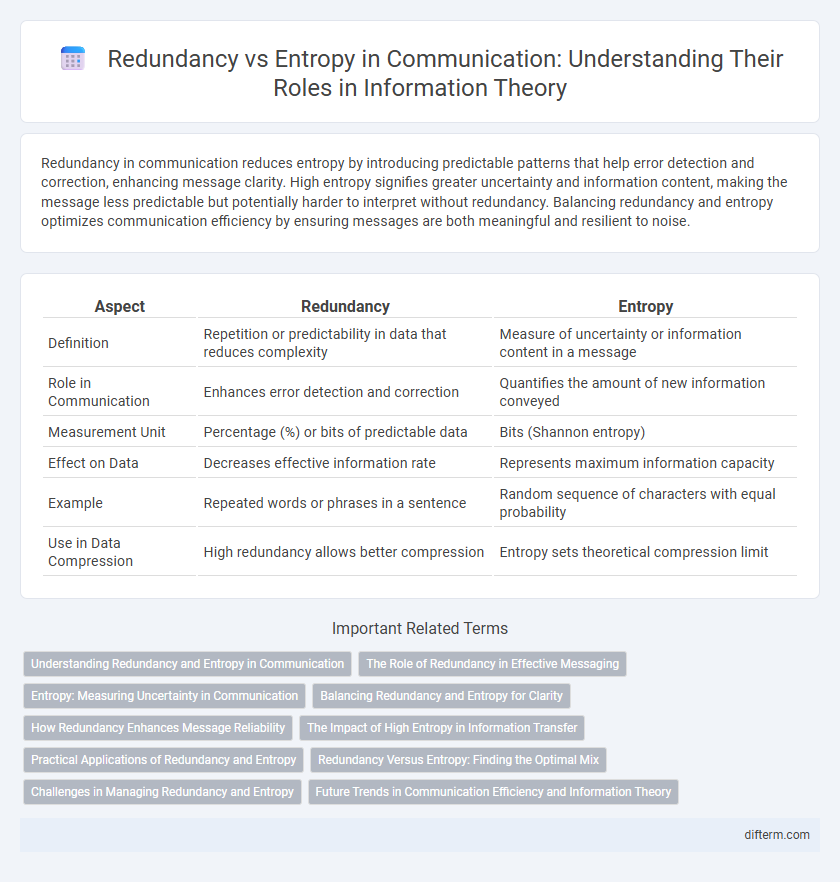Redundancy in communication reduces entropy by introducing predictable patterns that help error detection and correction, enhancing message clarity. High entropy signifies greater uncertainty and information content, making the message less predictable but potentially harder to interpret without redundancy. Balancing redundancy and entropy optimizes communication efficiency by ensuring messages are both meaningful and resilient to noise.
Table of Comparison
| Aspect | Redundancy | Entropy |
|---|---|---|
| Definition | Repetition or predictability in data that reduces complexity | Measure of uncertainty or information content in a message |
| Role in Communication | Enhances error detection and correction | Quantifies the amount of new information conveyed |
| Measurement Unit | Percentage (%) or bits of predictable data | Bits (Shannon entropy) |
| Effect on Data | Decreases effective information rate | Represents maximum information capacity |
| Example | Repeated words or phrases in a sentence | Random sequence of characters with equal probability |
| Use in Data Compression | High redundancy allows better compression | Entropy sets theoretical compression limit |
Understanding Redundancy and Entropy in Communication
Redundancy in communication refers to the repetition of information that enhances message clarity and error detection, ensuring accurate transmission despite noise. Entropy measures the unpredictability or information content within a message, quantifying the degree of uncertainty before receiving the message. Balancing redundancy and entropy is critical for optimizing communication efficiency, reducing errors while maximizing information throughput.
The Role of Redundancy in Effective Messaging
Redundancy enhances effective messaging by reducing entropy, ensuring messages remain comprehensible despite noise and potential errors. By repeating or rephrasing key information, redundancy increases the likelihood that the receiver accurately decodes the intended meaning. Consequently, controlled redundancy optimizes communication clarity, improving message reliability in various transmission environments.
Entropy: Measuring Uncertainty in Communication
Entropy quantifies the uncertainty or unpredictability in a communication system, reflecting the average amount of information produced by a stochastic source of data. It is measured in bits and serves as a fundamental metric for evaluating the efficiency and reliability of information transmission. High entropy indicates greater diversity and complexity in messages, which requires more robust encoding to minimize uncertainty in communication channels.
Balancing Redundancy and Entropy for Clarity
Balancing redundancy and entropy is crucial for clear communication, as redundancy provides necessary repetition to prevent misunderstandings, while entropy represents the information uncertainty that drives message novelty. Excessive redundancy leads to predictability and boredom, whereas high entropy can cause confusion due to overly complex or unpredictable content. Effective communication optimizes this balance to ensure messages are both understandable and engaging, leveraging the principles of information theory to enhance clarity and retention.
How Redundancy Enhances Message Reliability
Redundancy enhances message reliability by introducing repetitive or predictable elements within communication, which helps receivers detect and correct errors caused by noise or interference. By increasing the amount of redundant information, the probability of accurately decoding the intended message improves despite transmission distortions. This mechanism reduces entropy--an indicator of uncertainty--thereby ensuring clearer and more robust information exchange in communication systems.
The Impact of High Entropy in Information Transfer
High entropy in information transfer increases unpredictability, reducing redundancy and making communication more efficient but potentially less reliable. Elevated entropy challenges error detection and correction mechanisms, necessitating advanced coding strategies to maintain message integrity. Optimizing the balance between entropy and redundancy is critical for enhancing data transmission quality in complex communication systems.
Practical Applications of Redundancy and Entropy
Redundancy in communication systems enhances error detection and correction, ensuring message integrity across noisy channels by repeating critical information. Entropy measures the unpredictability of a message, guiding efficient data compression techniques to minimize bandwidth usage while preserving essential content. Practical applications range from reliable digital transmissions in telecommunications to optimized data storage solutions in computing networks.
Redundancy Versus Entropy: Finding the Optimal Mix
Balancing redundancy and entropy is crucial in communication systems to enhance message clarity and efficiency. Redundancy reduces errors by repeating information, while entropy measures the unpredictability or information content of a message, with higher entropy indicating more complexity. Finding the optimal mix involves minimizing redundancy to avoid wastage of bandwidth while maintaining enough to correct errors, ensuring reliable and efficient data transmission.
Challenges in Managing Redundancy and Entropy
Managing redundancy in communication systems demands a careful balance to avoid information overload that hampers message clarity. High entropy increases uncertainty, making it difficult to predict message content, thus complicating error detection and correction. Efficient communication strategies must minimize unnecessary redundancy while controlling entropy to ensure accurate and reliable information transmission.
Future Trends in Communication Efficiency and Information Theory
Advancements in communication technology prioritize reducing redundancy while managing entropy to maximize information transmission efficiency. Future trends leverage sophisticated algorithms and machine learning to optimize data compression and error correction, ensuring minimal loss of information despite increased entropy. Innovations in quantum communication and adaptive coding techniques aim to balance redundancy and entropy, enhancing reliability and speed in next-generation networks.
redundancy vs entropy Infographic

 difterm.com
difterm.com